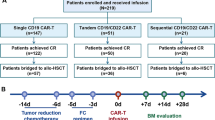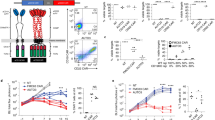Abstract
Tisagenlecleucel therapy has shown promising efficacy for relapsed/refractory (R/R) B-cell precursor acute lymphoblastic leukemia (BCP-ALL). However, relapses occur in 30–50% of patients. Determinants for CD19pos versus CD19neg relapses are poorly characterized. We report on 51 patients with R/R BCP-ALL (median age 17 years) infused with tisagenlecleucel after lymphodepletion. Complete remission rate at D28 was 96%. Prior blinatumomab increased the risk of early failure at D28. The 18-month cumulative incidence of relapse (CIR), event-free survival (EFS), and overall survival (OS) were 51%, 44%, and 74%, respectively, at a median follow-up of 15.5 months. Factors associated with a high tumor burden (occurrence of cytokine release syndrome) and prior blinatumomab were associated with an increased CIR, and a shorter EFS and OS. Pre-lymphodepletion high disease burden (MRD ≥ 10–2, SHR 10.4, p = 0.03) and detectable MRD at D28 (SHR 7.2, p = 0.006) correlated with an increased risk of CD19neg relapse. Low disease burden (SHR 5.3, p = 0.03) and loss of B-cell aplasia (BCA) (SHR 21.7, p = 0.004) predicted an increased risk of CD19pos relapses. These data highlight the impact of prior therapy on patient outcome. Finally, detectable MRD at D28 and loss of BCA both define patients at high risk of relapse for whom additional interventions are needed.
This is a preview of subscription content, access via your institution
Access options
Subscribe to this journal
Receive 12 print issues and online access
$259.00 per year
only $21.58 per issue
Buy this article
- Purchase on Springer Link
- Instant access to full article PDF
Prices may be subject to local taxes which are calculated during checkout




Similar content being viewed by others
References
Pui C-H, Evans WE. A 50-year journey to cure childhood acute lymphoblastic leukemia. Semin Hematol. 2013;50:185–96.
Boissel N, Baruchel A. Acute lymphoblastic leukemia in adolescent and young adults: treat as adults or as children? Blood. 2018;132:351–61.
Sun W, Malvar J, Sposto R, Verma A, Wilkes JJ, Dennis R, et al. Outcome of children with multiply relapsed B-cell acute lymphoblastic leukemia: a therapeutic advances in childhood leukemia & lymphoma study. Leukemia. 2018;32:2316–25.
Locatelli F, Zugmaier G, Bader P, Jeha S, Schlegel P-G, Bourquin J-P, et al. Blinatumomab in pediatric patients with relapsed/refractory B-cell precursor and molecularly resistant acute lymphoblastic leukemia (R/R ALL): updated analysis of 110 patients treated in an Expanded Access Study (RIALTO). Blood. 2019;134:1294.
Bhojwani D, Sposto R, Shah NN, Rodriguez V, Yuan C, Stetler-Stevenson M, et al. Inotuzumab ozogamicin in pediatric patients with relapsed/refractory acute lymphoblastic leukemia. Leukemia. 2019;33:884–92.
Kantarjian H, Stein A, Gökbuget N, Fielding AK, Schuh AC, Ribera J-M, et al. Blinatumomab versus chemotherapy for advanced acute lymphoblastic leukemia. N Engl J Med. 2017;376:836–47.
Kantarjian HM, DeAngelo DJ, Stelljes M, Martinelli G, Liedtke M, Stock W, et al. Inotuzumab ozogamicin versus standard therapy for acute lymphoblastic leukemia. N Engl J Med. 2016;375:740–53.
Brown PA, Ji L, Xu X, Devidas M, Hogan L, Borowitz MJ, et al. A randomized phase 3 trial of blinatumomab vs. chemotherapy as post-reinduction therapy in high and intermediate risk (HR/IR) first relapse of B-acute lymphoblastic leukemia (B-ALL) in children and adolescents/young adults (AYAs) demonstrates superior efficacy and tolerability of blinatumomab: a report from Children’s Oncology Group Study AALL1331. Blood. 2019;134:LBA–LBA-1.
Maude SL, Laetsch TW, Buechner J, Rives S, Boyer M, Bittencourt H, et al. Tisagenlecleucel in children and young adults with B-cell lymphoblastic leukemia. N Engl J Med. 2018;378:439–48.
Grupp SA, Maude SL, Rives S, Baruchel A, Boyer MW, Bittencourt H, et al. Updated analysis of the efficacy and safety of tisagenlecleucel in pediatric and young adult patients with relapsed/refractory (R/R) acute lymphoblastic leukemia. Blood. 2018;132:895.
Grupp S, Hu Z-H, Zhang Y, Keating A, Pulsipher MA, Philips C, et al. Tisagenlecleucel chimeric antigen receptor (CAR) T-cell therapy for relapsed/refractory children and young adults with acute lymphoblastic leukemia (ALL): real world experience from the Center for International Blood and Marrow Transplant Research (CIBMTR) and Cellular Therapy (CT) Registry. Blood. 2019;134:2619.
Dourthe M-E, Rabian F, Yakouben K, Cabannes A, Chevillon F, Chaillou D, et al. Safety and efficacy of tisagenlecleucel (CTL019) in B-cell acute lymphoblastic leukemia in children, adolescents and young adults: the French experience. Blood. 2019;134:3876.
Pasquini MC, Hu Z-H, Curran K, Laetsch T, Locke F, Rouce R, et al. Real-world evidence of tisagenlecleucel for pediatric acute lymphoblastic leukemia and non-Hodgkin lymphoma. Blood Adv. 2020;4:5414–24.
Lee DW, Santomasso BD, Locke FL, Ghobadi A, Turtle CJ, Brudno JN, et al. ASTCT consensus grading for cytokine release syndrome and neurologic toxicity associated with immune effector cells. Biol Blood Marrow Transpl. 2019;25:625–38.
Grambsch PM, Therneau TM. Proportional hazards tests and diagnostics based on weighted residuals. Biometrika. 1994;81:515–26.
Mantel N, Byar DP. Evaluation of response-time data involving transient states: an illustration using heart-transplant data. J Am Stat Assoc. 1974;69:81–6.
Simon R, Makuch RW. A non-parametric graphical representation of the relationship between survival and the occurrence of an event: application to responder versus non-responder bias. Stat Med. 1984;3:35–44.
Baruchel A. Tisagenlecleucel for pediatric/young adult patients with relapsed/refractory B-Cell acute lymphoblastic leukemia: preliminary report of B2001X focusing on prior exposure to blinatumomab and inotuzumab. HemaSphere. 2020;4(S1):10.
Pillai V, Muralidharan K, Meng W, Bagashev A, Oldridge DA, Rosenthal J, et al. CAR T-cell therapy is effective for CD19-dim B-lymphoblastic leukemia but is impacted by prior blinatumomab therapy. Blood Adv. 2019;3:3539–49.
Gardner RA, Finney O, Annesley C, Brakke H, Summers C, Leger K, et al. Intent-to-treat leukemia remission by CD19 CAR T cells of defined formulation and dose in children and young adults. Blood 2017;129:3322–31.
Finney OC, Brakke HM, Rawlings-Rhea S, Hicks R, Doolittle D, Lopez M, et al. CD19 CAR T cell product and disease attributes predict leukemia remission durability. J Clin Invest. 2019;129:2123–32.
Annesley C, Gardner R, Finney O, Summers C, Lamble AJ, Rivers J, et al. Novel CD19t T-antigen presenting cells designed to re-activate and expand CD19 CAR T cells in vivo: early demonstration of feasibility and safety. Blood. 2018;132:4021.
Hay KA, Gauthier J, Hirayama AV, Voutsinas JM, Wu Q, Li D, et al. Factors associated with durable EFS in adult B-cell ALL patients achieving MRD-negative CR after CD19 CAR T-cell therapy. Blood. 2019;133:1652–63.
Curran KJ, Margossian SP, Kernan NA, Silverman LB, Williams DA, Shukla N, et al. Toxicity and response after CD19-specific CAR T-cell therapy in pediatric/young adult relapsed/refractory B-ALL. Blood. 2019;134:2361–8.
Lee DW, Kochenderfer JN, Stetler-Stevenson M, Cui YK, Delbrook C, Feldman SA, et al. T cells expressing CD19 chimeric antigen receptors for acute lymphoblastic leukaemia in children and young adults: a phase 1 dose-escalation trial. Lancet Lond Engl. 2015;385:517–28.
Orlando EJ, Han X, Tribouley C, Wood PA, Leary RJ, Riester M, et al. Genetic mechanisms of target antigen loss in CAR19 therapy of acute lymphoblastic leukemia. Nat Med. 2018;24:1504–6.
Singh N, Orlando E, Xu J, Xu J, Binder Z, Collins MA, et al. Mechanisms of resistance to CAR T cell therapies. Semin Cancer Biol. 2020;65:91–8.
Zhao Y, Aldoss I, Qu C, Crawford JC, Gu Z, Allen EK, et al. Tumor-intrinsic and -extrinsic determinants of response to blinatumomab in adults with B-ALL. Blood. 2021;137:471–84.
Pulsipher MA, Han X, Quigley M, Kari G, Rives S, Laetsch TW, et al. Molecular detection of minimal residual disease precedes morphological relapse and could be used to identify relapse in pediatric and young adult B-cell acute lymphoblastic leukemia patients treated with tisagenlecleucel. Blood 2018;132:1551.
Acknowledgements
The authors would like to thank all the clinicians who referred patients to Robert Debré and Saint Louis University Hospitals (AP-HP) for apheresis and tisagenlecleucel treatment: Dr B Gruson from Amiens University Hospital; Dr JF Brasme from Angers University Hospital; Dr A Berceanun, Dr N Cheikh from Besancon University Hospital; Dr S Ducassou and Dr C Jubert from Bordeaux University Hospital; Dr G Guillerm from Brest University Hospital; Pr Justyna Kanold from Clermont-Ferrand University Hospital; Dr M Leclerc from Créteil University Hospital; Dr Y Hatchuel from Fort de France University Hospital; Dr Y Reguerre from La Réunion University Hospital; Dr C Berthon, Dr B Bruno, Dr E Deberranger, and Dr V Coiteux from Lille University Hospital; Dr MV Larcher from Lyon University Hospital; Dr Curtillet, Dr C Galambrun, Dr A Stérin, and Pr G Michel from Marseille University Hospital; Dr C Pochon and Dr C Schmitt from Nancy University Hospital; Dr L Legros from Nice University Hospital; Dr M Uzunov from La Pitié Salpétrière University Hospital, Paris; Dr N Maillard from Poitiers University Hospital; Pr V Gandemer and Pr T Lamy de la Chapelle from Rennes University Hospital; Dr N Buchbinder, Pr P Schneider, Dr F Jardin, and Dr AL Menard from Rouen University Hospital; Pr C Paillard from Strasbourg University Hospital; Dr F Huguet and Dr G Plat from Toulouse University Hospital; Pr E Gyan from Tours University Hospital; Dr H Boutroux, Dr C Dollfus, Dr J Donadieu, Dr M Simonin, Pr Petit, and Pr Leverger from Armand-Trousseau University Hospital, Paris; Dr U Overgaard from University Hospital of Copenhagen.
Author information
Authors and Affiliations
Contributions
M-ED, FR, NB, and ABaruchel conceived the study and oversaw the project; M-ED, FR, KY, FC, AC-H, IR, ND, DC, EL, JN, JR-S, NP, ABrignier, VG-EK, EA, JHD, IM, JL, NB, and ABaruchel provided patients or materials; SC-Z, EL AC-E, HC, EC, and SM provided biological analysis; M-ED, FR, and AC-H collected and assembled data; NB performed statistical analysis, M-ED, FR, NB, and ABaruchel analyzed and interpreted data; M-ED, FR, NB, and ABaruchel wrote the manuscript. All authors approved the manuscript.
Corresponding author
Ethics declarations
Conflict of interest
NB receives honoraria from Novartis, Amgen, and Pfizer. ABaruchel receives honoraria from Novartis, Celgene, Servier, Jazz, and Astra-Zeneca.
Additional information
Publisher’s note Springer Nature remains neutral with regard to jurisdictional claims in published maps and institutional affiliations.
Supplementary information
Rights and permissions
About this article
Cite this article
Dourthe, ME., Rabian, F., Yakouben, K. et al. Determinants of CD19-positive vs CD19-negative relapse after tisagenlecleucel for B-cell acute lymphoblastic leukemia. Leukemia 35, 3383–3393 (2021). https://doi.org/10.1038/s41375-021-01281-7
Received:
Revised:
Accepted:
Published:
Issue Date:
DOI: https://doi.org/10.1038/s41375-021-01281-7
This article is cited by
-
Gene editing technology to improve antitumor T-cell functions in adoptive immunotherapy
Inflammation and Regeneration (2024)
-
Intention-to-treat outcomes utilising a stringent event definition in children and young people treated with tisagenlecleucel for r/r ALL through a national access scheme
Blood Cancer Journal (2024)
-
Safety and efficacy of co-administration of CD19 and CD22 CAR-T cells in children with B-ALL relapse after CD19 CAR-T therapy
Journal of Translational Medicine (2023)
-
Mechanisms of resistance to chimeric antigen receptor-T cells in haematological malignancies
Nature Reviews Drug Discovery (2023)
-
Long-term outcomes following CAR T cell therapy: what we know so far
Nature Reviews Clinical Oncology (2023)



